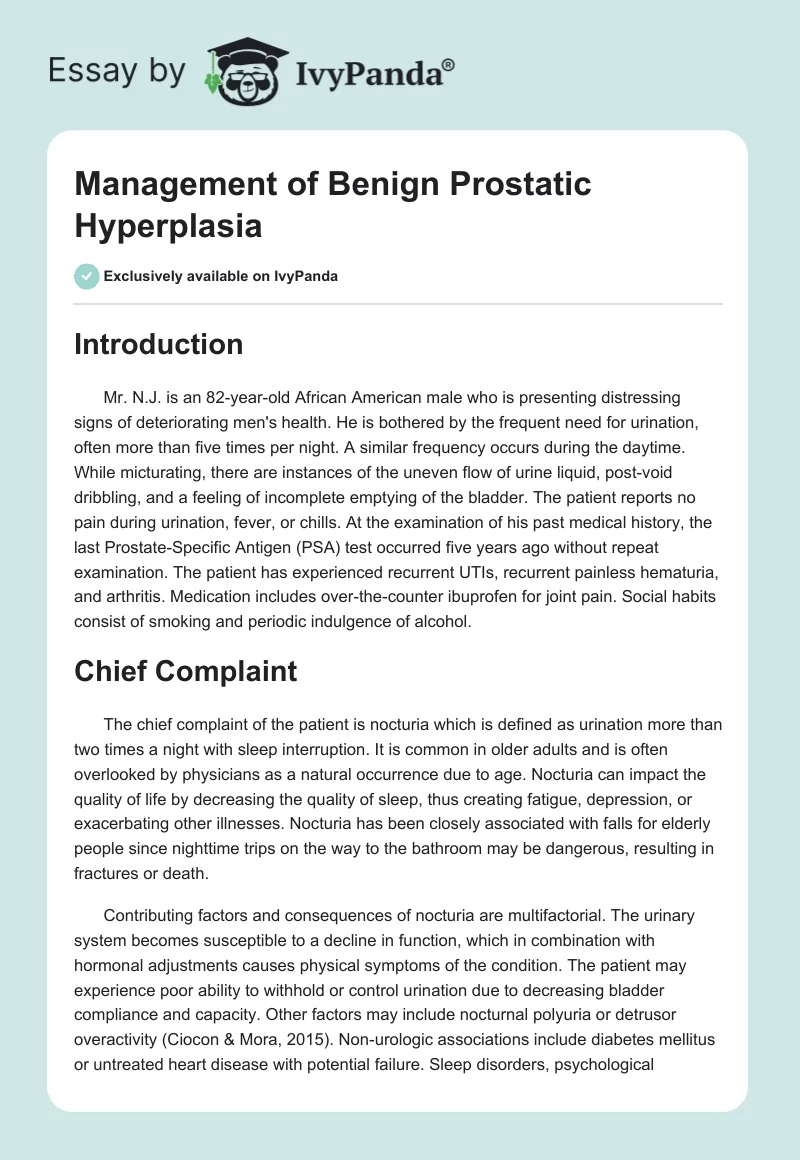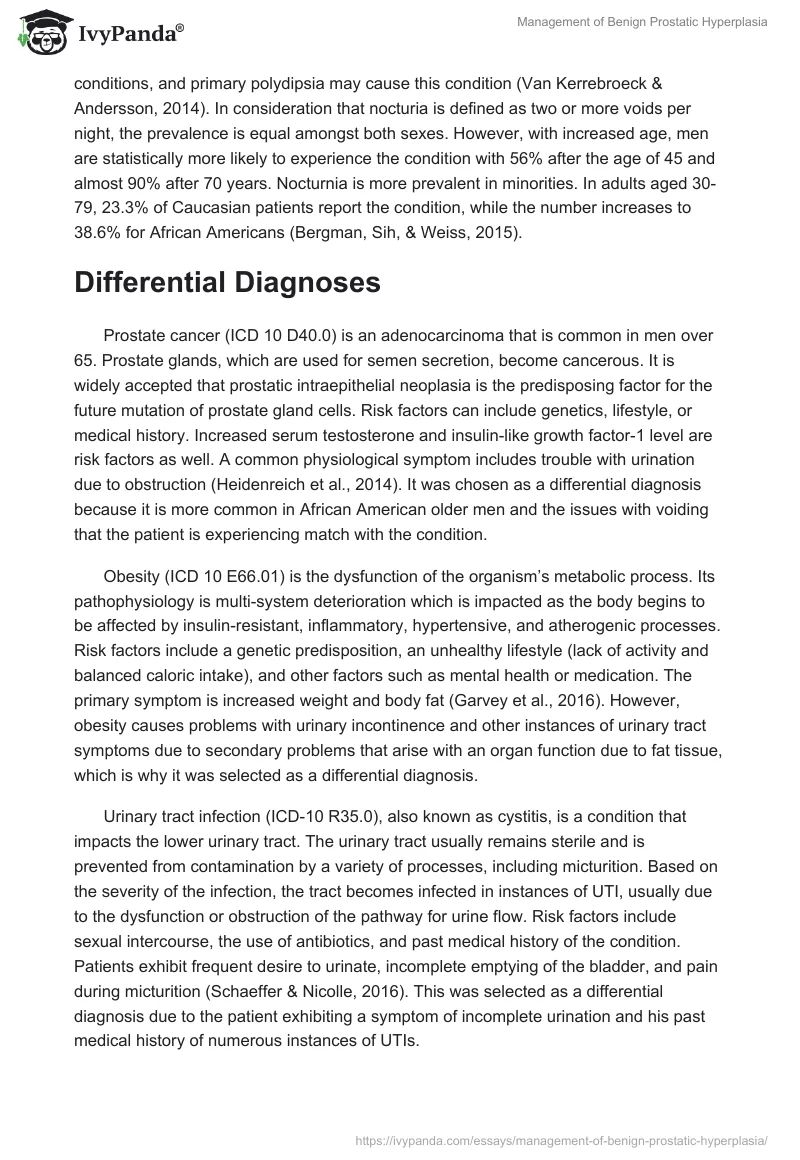Introduction
Mr. N.J. is an 82-year-old African American male who is presenting distressing signs of deteriorating men’s health. He is bothered by the frequent need for urination, often more than five times per night. A similar frequency occurs during the daytime. While micturating, there are instances of the uneven flow of urine liquid, post-void dribbling, and a feeling of incomplete emptying of the bladder. The patient reports no pain during urination, fever, or chills. At the examination of his past medical history, the last Prostate-Specific Antigen (PSA) test occurred five years ago without repeat examination. The patient has experienced recurrent UTIs, recurrent painless hematuria, and arthritis. Medication includes over-the-counter ibuprofen for joint pain. Social habits consist of smoking and periodic indulgence of alcohol.
Chief Complaint
The chief complaint of the patient is nocturia which is defined as urination more than two times a night with sleep interruption. It is common in older adults and is often overlooked by physicians as a natural occurrence due to age. Nocturia can impact the quality of life by decreasing the quality of sleep, thus creating fatigue, depression, or exacerbating other illnesses. Nocturia has been closely associated with falls for elderly people since nighttime trips on the way to the bathroom may be dangerous, resulting in fractures or death.
Contributing factors and consequences of nocturia are multifactorial. The urinary system becomes susceptible to a decline in function, which in combination with hormonal adjustments causes physical symptoms of the condition. The patient may experience poor ability to withhold or control urination due to decreasing bladder compliance and capacity. Other factors may include nocturnal polyuria or detrusor overactivity (Ciocon & Mora, 2015). Non-urologic associations include diabetes mellitus or untreated heart disease with potential failure. Sleep disorders, psychological conditions, and primary polydipsia may cause this condition (Van Kerrebroeck & Andersson, 2014). In consideration that nocturia is defined as two or more voids per night, the prevalence is equal amongst both sexes. However, with increased age, men are statistically more likely to experience the condition with 56% after the age of 45 and almost 90% after 70 years. Nocturnia is more prevalent in minorities. In adults aged 30-79, 23.3% of Caucasian patients report the condition, while the number increases to 38.6% for African Americans (Bergman, Sih, & Weiss, 2015).
Differential Diagnoses
Prostate cancer (ICD 10 D40.0) is an adenocarcinoma that is common in men over 65. Prostate glands, which are used for semen secretion, become cancerous. It is widely accepted that prostatic intraepithelial neoplasia is the predisposing factor for the future mutation of prostate gland cells. Risk factors can include genetics, lifestyle, or medical history. Increased serum testosterone and insulin-like growth factor-1 level are risk factors as well. A common physiological symptom includes trouble with urination due to obstruction (Heidenreich et al., 2014). It was chosen as a differential diagnosis because it is more common in African American older men and the issues with voiding that the patient is experiencing match with the condition.
Obesity (ICD 10 E66.01) is the dysfunction of the organism’s metabolic process. Its pathophysiology is multi-system deterioration which is impacted as the body begins to be affected by insulin-resistant, inflammatory, hypertensive, and atherogenic processes. Risk factors include a genetic predisposition, an unhealthy lifestyle (lack of activity and balanced caloric intake), and other factors such as mental health or medication. The primary symptom is increased weight and body fat (Garvey et al., 2016). However, obesity causes problems with urinary incontinence and other instances of urinary tract symptoms due to secondary problems that arise with an organ function due to fat tissue, which is why it was selected as a differential diagnosis.
Urinary tract infection (ICD-10 R35.0), also known as cystitis, is a condition that impacts the lower urinary tract. The urinary tract usually remains sterile and is prevented from contamination by a variety of processes, including micturition. Based on the severity of the infection, the tract becomes infected in instances of UTI, usually due to the dysfunction or obstruction of the pathway for urine flow. Risk factors include sexual intercourse, the use of antibiotics, and past medical history of the condition. Patients exhibit frequent desire to urinate, incomplete emptying of the bladder, and pain during micturition (Schaeffer & Nicolle, 2016). This was selected as a differential diagnosis due to the patient exhibiting a symptom of incomplete urination and his past medical history of numerous instances of UTIs.
Discussion
Out of all the differential diagnoses, obesity remains the most distinguished. Even if the patient is diagnosed with obesity, it does not necessarily explain his symptoms. Urination is impacted by obesity due to dysfunctional metabolic processes, high blood sugar, and possibly inflammation, which are affecting the urinary tract indirectly. Although treating obesity may relieve the symptoms, this diagnosis unlikely the cause. Prostate cancer, UTI, and BPH are all similar in the fact that they affect the prostate region, although, UTI is focused directly on the lower urinary tract. Prostate cancer exhibits symptoms of urinary obstruction, which may cause UTI in the long run. BPH is caused by an enlarged prostate gland that pushes the bladder but, in contrast to prostate cancer, the organ cells do not become carcinogenic. Post-void dripping exhibited by the patient can occur both in BPH and a urinary tract infection as well.
Testing
The main tools for the diagnosis of prostate cancer consist of serum concentration of PSA, DRE, and a transrectal ultrasound-guided biopsy. These results produce values that can be used to determine the risk of prostate cancer. Multi-stage biopsies can be a more accurate indicator of the severity of the case (Heidenreich et al., 2014). Obesity is determined by the measurement of the body mass index (BMI) which stands for the value of mass distributed in the body. Ranges of 30 and higher are considered to be obese. There may be additional diagnostic testing such as a bioimpedance and a body fat percentage measurement. Usually, obesity requires further testing of blood plasma for various co-morbidities (Garvey et al., 2016). For a UTI, testing requires providing a urine sample which is utilized for bacterial culture. In conjunction with other physiological symptoms and examinations, a diagnosis can be established (Schaeffer & Nicolle, 2016).
Final Diagnosis
After a careful examination of differentials in comparison to the chief complaint and other symptoms exemplified by the patient, it is recommended to establish benign prostatic hyperplasia (BPH) (ICD 10 N40.1) as the primary diagnosis. Nocturia is considered an irritative symptom of BPH. BPH patients with nocturia exhibited co-morbidities of conditions such as obesity and decreased prostate volume in combination with lifestyle habits such as alcohol intake and smoking (Singam et al., 2015). This alignment of potential causing factors and consequential physiology makes BPH a probable diagnosis for the patient in the scenario. However, it should be noted that the listed co-morbidities may negatively impact the effectiveness of treatment and complete the elimination of any pathophysiological symptoms.
National Guidelines
Benign prostatic hyperplasia is a diagnosis that indicates an increase of muscle and epithelial cells in the prostatic transition zone. It is suggested that the enlarged gland is the cause of the lower urinary tract symptoms (LUTS) complex. This happens either through continuous bladder outlet obstruction (BOO) due to static tissue or the increase of muscle tone and resistance within the gland which is dynamic. Urination is attributed to the symptoms of BOO. An initial evaluation attempts to determine the signs of LUTS and whether there is any suspicious enlargement of the prostate which may suggest more critical issues such as prostate cancer or hematuria. Otherwise, meditative or non-invasive treatment can be conducted without further tests. Patients experiencing nocturia should use a frequency volume chart to determine patterns of urination. Modifiable lifestyle factors such as fluid intake, lifestyle choices, and diet should be considered. Treatment with desmopressin is recommended if symptoms persist (American Urological Association, 2014).
Testing and Treatment
Laboratory testing should be performed for patients with suspicion of BPH/LUTS. Urinalysis helps to find glucosuria, pyuria, and hematuria. Serum creatinine is meant to check for renal insufficiency which may have occurred due to obstructive uropathy. Prostate-specific antigens may be used, but elevated results do not distinguish between BPH and prostate cancer, although the two are not necessarily mutually exclusive. Some other tests include transrectal ultrasound to measure prostate volume and post-void residual to determine the amount of fluid left in the bladder after urination. Outside of lifestyle changes and modifications to fluid intake, medical management may be utilized. Alpha-blockers improve irritative and obstructive symptoms which hinder urinary flow by relieving smooth muscle tone in the prostate. These include FDA-approved Alfuzosin (10 mg daily) and Doxazosin (1 or 4 mg daily dependent on release). 5-alpha reductase inhibitors which aid in blocking DHT conversion and phosphodiesterase type-5 inhibitors that stimulate relaxing blood flow to the endothelial and smooth muscles are other available treatment options (Kim, Larson, & Andriole, 2015).
References
American Urological Association (2014). Management of benign prostatic hyperplasia (BPH). Web.
Bergman, A., Sih, A., & Weiss, J. P. (2015). Nocturia: An overview of evaluation and treatment. The bladder, 2(2), e13. Web.
Ciocon, J., & Mora, J. C. (2015). Nocturia in older adults. Web.
Garvey, T. W., Mechanick, J. I., Brett, E. M., Garber, A. J., Hurley, D. L., Jastreboff, A. M., … Plodkowski, R. (2016). American Association of Clinical Endocrinologists and American College of Endocrinology comprehensive clinical practice guidelines for medical care of patients with obesity. Endocrine Practice, 22(3), 1-203. Web.
Heidenreich, A., Bastian, P. J., Bellmunt, J., Bolla, M., Joniau, S., van der Kwast, T., … Mottet, N. (2014). EAU guidelines on prostate cancer. Part 1: Screening, diagnosis, and local treatment with curative intent—Update 2013. European Urology, 65(1), 124-137. Web.
Kim, E. H., Larson, J. A, & Andriole, G. L. (2015). Management of benign prostatic hyperplasia. Annual Review of Medicine, 67, 137-151. Web.
Schaeffer, A., & Nicolle, L. (2016). Urinary tract infections in older men. The New England Journal of Medicine, 374, 562-571. Web.
Singam, P., Hong, G. E., Ho, C., Hee, T. G., Jasman, H., Inn, F. X., … Zainuddin, Z. (2015). Nocturia in patients with benign prostatic hyperplasia: evaluating the significance of ageing, co-morbid illnesses, lifestyle and medical therapy in treatment outcome in real life practice. The Aging Male, 18(2), 112-117. Web.
Van Kerrebroeck, P., & Andersson, K. (2014). Terminology, epidemiology, etiology, and pathophysiology of nocturia. Neuroulogy and Urodynamics, 33(1), 52-55. Web.


